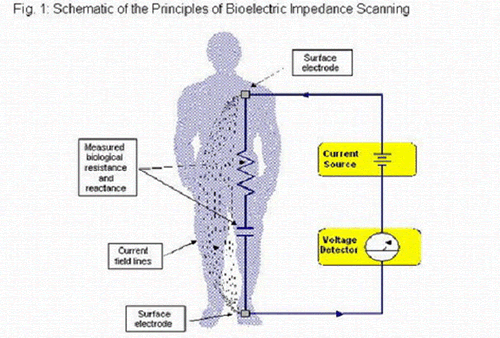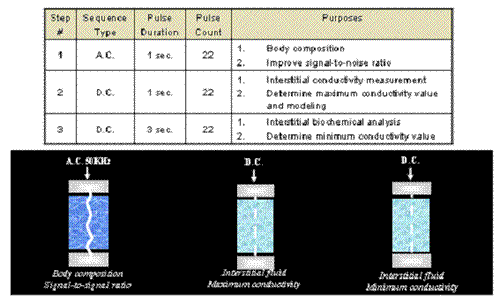| Click here to go back |
Introduction |
| Bioelectric Impedance measurements (BIM) represents a wide range of old and new non-invasive technologies and methods where a very small electric current is applied to the body via one or more surface electrode and the resultant current passing through the body is detected at other surface electrodes placed elsewhere on the body. A drop in voltage occurs as the current encounters impedance or resistance inherent in the fluids and tissues it passes through as it courses through the various physiological “compartments” of the body.1-3 These compartments include the bloodstream, the intracellular space, the lymphatic system, the interstitial space, and others.4,5 This drop in voltage provides indirect information about the physical and chemical properties of the compartment(s) that the current passed through. Technically, the term “impedance” refers to A.C. forms of electricity and the term “resistance” refers to D.C. |
|
| |
| Alternating Current Bioelectric Impedance Methods: |
| The most familiar form of BIM uses an alternating current (A.C.) system. There are dozens of readily available commercial and custom-built A.C. BIM systems differing widely in design and complexity.6 Most systems are used to indirectly estimate the fat content of the body by measuring total body water.7,8 These systems typically employ A.C. electricity with a wide range of currents, frequencies, and voltage. The amount of electricity delivered to the body is usually imperceptible and far below the level that would cause cellular or tissue damage.9,10 Studies of A.C. BIM systems operating at 50 MHz or higher, have revealed that these high frequency A.C. electric currents flow non-selectively through both intracellular and extra cellular spaces11 (see image below), and thus provide relatively non-specific information regarding the physical properties and chemical composition of total body water. Recently, the FDA approved several A.C. BIM devices for use as diagnostic aids in cardiology and oncology. |
|
| |
 |
| |
| Direct Current Bioelectric Impedance Methods |
| |
 Unlike A.C. bioelectric impedance, the electric current produced Unlike A.C. bioelectric impedance, the electric current produced
by D.C. bioelectric impedance methods specifically passes through the interstitial fluid compartment 23 (seeimage below). The interstitial fluid compartment represents approximately 16% of the body’s total water.24-26 Interstitial fluid is extra cellular water and solutes surrounding cells, but outside of the bloodstream and lymphatic system. Interstitial fluid forms the microscopic interface between cells and capillaries. Interstitial fluid differs from whole blood by the absence of red blood cells, and it differs from blood plasma in that there are far fewer proteins. Any substance passing between cells and the bloodstream must traverse the
interstitial space. These substances include oxygen, carbon dioxide, glucose, as well as thousands of other compounds.27,28 The interstitial fluid’s role as a metabolic conduit and its proximity to the collective intracellular space of nearby cells suggests that the chemical composition of the interstitial fluid may reflect the physiology (or pathophysiology) of nearby cells.29-31 Since D.C. electric current primarily passes through
the interstitial fluid, it has been proposed that an abnormality in the chemical composition of the interstitial fluid could be detected with an adequately sensitive D.C. BIM device. |
|
| How The EIS System’s Advanced Patented Technology Functions |
| |
| During the 2 minute test, The EIS System generates 3 diverse pulse frequencies with 3 consecutive tests of different time duration. (See below) |
|
| |
| |
 |
| |
Sequence and Volumes of measurement |
| |
| During the initial test a AC 50 KHz and then a AC 200 KHz is passed between the electrodes of the hands and the feet according to a tetrapode measurement process |
|
| |
| |
Anode |
|
Cathode |
| 7 |
R.hand |
 |
R.foot |
| 5 |
L.hand |
 |
L.foot |
  |
|
| |
| The impedance measured is then forwarded to The EIS Software via the USB port. |
| |
| AC Measurements for Fat Mass and Total Body Water |
| In sending a 200KHz signal into the body The EIS Software then calculates the total body water (TBW) with the impedance Z according to the mathematical formula: v= ρ Ht2 /Z. The extra cellular water also be calculated using the same formula with the impedance Z by sending a 50KHz signal through the body. |
| The calculation of the fat mass (FM) is calculated with the following formula: |
| Lean mass =TBW in Kg / 0.732 |
| FM in Kg = Total weight – Lean mass |
| |
| DC Measurements for Interstitial Fluid Analysis |
| During the DC measurement process the examination is carried out between the 6 tactile electrodes placed on the forehead, hands and feet. Each electrode will alternate from a cathode to an anode to enable 22 volumes of the interstitial fluid of the human body to be measured. |
| This measurement is conducted twice during the 2 minute test for 1 second and then for 3 seconds. |
| The below diagram represents the 22 volumes being measured with the alternating anode and cathode. |
|
| |
| |
 |
| |
| The Process during the 1 second DC measurement: |
| The intensity values are transmitted to The EIS Software via the USB port, in numerical form for each volume measured. The software converts these values into a conductivity value (application of the law of Ohm U=RI then C= 1/R) and displays this information on a graph format. |
| |
The graph of 22 volumes is called ElectroScanGram (ESG).
This ESG graph was the subject of various clinical investigations and a statistical analysis in order to validate the examination as a marker or screening or follow up of certain pathologies and as a modeling of the human body.
|
|
| |
| The process during the 3 second DC measurement: |
| The intensity values are transmitted to The EIS Software via the USB port, in numerical form. The software converts these values into biochemical values by applying the Cottrell equation. |
|